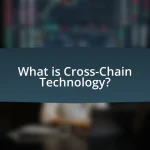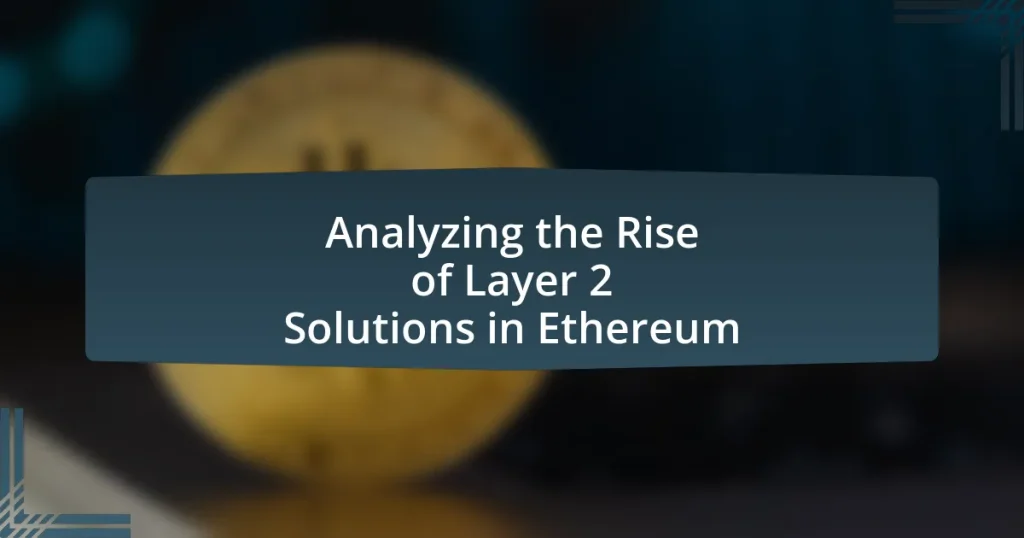Layer 2 solutions in Ethereum are advanced technologies aimed at enhancing the scalability and efficiency of the Ethereum blockchain by processing transactions off the main chain. This article analyzes the various types of Layer 2 solutions, including Optimistic Rollups and zk-Rollups, and their impact on transaction speed, cost reduction, and overall user experience. It also addresses the challenges Ethereum faces, such as high gas fees and network congestion, and how Layer 2 solutions mitigate these issues. Additionally, the article explores the key players in the Layer 2 ecosystem, emerging trends, and best practices for users to maximize the benefits of these solutions while ensuring the security of their assets.

What are Layer 2 Solutions in Ethereum?
Layer 2 solutions in Ethereum are technologies designed to improve the scalability and efficiency of the Ethereum blockchain by processing transactions off the main chain. These solutions, such as Optimistic Rollups and zk-Rollups, enable faster transaction speeds and lower fees while maintaining the security of the Ethereum network. For instance, according to a report by the Ethereum Foundation, Layer 2 solutions can increase transaction throughput significantly, allowing thousands of transactions per second compared to the main chain’s limitations.
How do Layer 2 Solutions enhance Ethereum’s scalability?
Layer 2 solutions enhance Ethereum’s scalability by processing transactions off the main Ethereum blockchain, thereby reducing congestion and increasing throughput. These solutions, such as rollups and state channels, allow for a higher volume of transactions to be executed in parallel, which significantly lowers gas fees and improves transaction speeds. For instance, optimistic rollups can increase Ethereum’s transaction capacity to thousands per second, compared to the main chain’s approximate 30 transactions per second. This off-chain processing alleviates the burden on the Ethereum network, enabling it to handle more users and applications efficiently.
What are the main types of Layer 2 Solutions available?
The main types of Layer 2 solutions available are state channels, sidechains, and rollups. State channels enable off-chain transactions between participants, allowing for instant and low-cost interactions while only settling on-chain when necessary. Sidechains operate independently of the main blockchain, facilitating transactions and smart contracts with their own consensus mechanisms, which can enhance scalability. Rollups, including Optimistic and ZK-Rollups, bundle multiple transactions into a single one, significantly reducing the load on the main chain while maintaining security through cryptographic proofs. These solutions collectively address scalability and transaction cost issues inherent in Ethereum’s Layer 1.
How do these solutions differ from Layer 1 solutions?
Layer 2 solutions differ from Layer 1 solutions primarily in their operational layer and scalability approach. Layer 1 solutions, such as Ethereum itself, handle transactions directly on the blockchain, which can lead to congestion and higher fees during peak usage. In contrast, Layer 2 solutions, like Optimistic Rollups or zk-Rollups, operate on top of the Layer 1 blockchain, processing transactions off-chain and then settling them back on the main chain. This off-chain processing significantly increases transaction throughput and reduces costs, as evidenced by the ability of Layer 2 solutions to handle thousands of transactions per second compared to the limited capacity of Layer 1.
Why is the rise of Layer 2 Solutions significant for Ethereum?
The rise of Layer 2 Solutions is significant for Ethereum because it addresses scalability issues, enabling the network to process transactions more efficiently. Layer 2 Solutions, such as Optimistic Rollups and zk-Rollups, allow for off-chain processing, which reduces congestion on the Ethereum mainnet. This is crucial as Ethereum’s transaction throughput is limited to approximately 30 transactions per second, leading to high gas fees and slower transaction times during peak demand. By utilizing Layer 2 Solutions, Ethereum can significantly increase its transaction capacity, enhance user experience, and support a growing ecosystem of decentralized applications.
What challenges does Ethereum face that Layer 2 Solutions address?
Ethereum faces scalability, high transaction fees, and network congestion challenges that Layer 2 solutions address. Scalability issues arise from Ethereum’s limited transaction throughput, which can handle approximately 30 transactions per second, leading to delays during peak usage. Layer 2 solutions, such as Optimistic Rollups and zk-Rollups, enhance scalability by processing transactions off-chain and then settling them on the Ethereum mainnet, significantly increasing throughput. High transaction fees, often exceeding $20 during congestion, are mitigated by Layer 2 solutions that reduce costs by batching transactions and minimizing on-chain activity. Additionally, network congestion, which can slow down transaction confirmation times, is alleviated as Layer 2 solutions distribute the transaction load, allowing for smoother and faster processing.
How do Layer 2 Solutions impact transaction costs on Ethereum?
Layer 2 solutions significantly reduce transaction costs on Ethereum by processing transactions off the main Ethereum blockchain. These solutions, such as Optimistic Rollups and zk-Rollups, aggregate multiple transactions into a single batch, which minimizes the gas fees associated with each individual transaction. For instance, according to a report by the Ethereum Foundation, Layer 2 solutions can lower transaction costs by up to 90% compared to on-chain transactions, making them a cost-effective alternative for users and developers.
What are the key players in the Layer 2 ecosystem?
The key players in the Layer 2 ecosystem include solutions like Optimism, Arbitrum, zkSync, and Polygon. These platforms enhance Ethereum’s scalability by processing transactions off-chain while maintaining security through the Ethereum mainnet. For instance, Optimism and Arbitrum utilize optimistic rollups, which allow for faster transaction speeds and lower fees by assuming transactions are valid unless proven otherwise. zkSync employs zero-knowledge rollups, providing privacy and efficiency by bundling multiple transactions into a single proof. Polygon, on the other hand, offers a multi-chain framework that supports various Layer 2 solutions, further expanding Ethereum’s capabilities. These players collectively contribute to addressing Ethereum’s congestion and high gas fees, making the network more accessible for users and developers.
Which projects are leading the development of Layer 2 Solutions?
The leading projects in the development of Layer 2 Solutions are Optimism, Arbitrum, and zkSync. Optimism utilizes optimistic rollups to enhance Ethereum’s scalability, while Arbitrum also employs optimistic rollups but focuses on compatibility with existing Ethereum smart contracts. zkSync, on the other hand, leverages zero-knowledge rollups to provide faster transactions and lower fees. These projects have gained significant traction, evidenced by their increasing adoption rates and the growing number of decentralized applications being built on their platforms.
How do these projects collaborate with Ethereum’s main network?
Layer 2 solutions collaborate with Ethereum’s main network by processing transactions off-chain while leveraging the security and decentralization of the Ethereum blockchain. These projects, such as Optimistic Rollups and zk-Rollups, bundle multiple transactions into a single batch, which is then submitted to the Ethereum mainnet, reducing congestion and lowering gas fees. For instance, Optimism and Arbitrum utilize this method to enhance scalability, allowing for faster transaction speeds and improved user experience while still relying on Ethereum’s security model for finality and dispute resolution.

What are the benefits of adopting Layer 2 Solutions?
Adopting Layer 2 solutions significantly enhances transaction speed and reduces costs on the Ethereum network. These solutions, such as Optimistic Rollups and zk-Rollups, process transactions off the main Ethereum blockchain, alleviating congestion and allowing for thousands of transactions per second. For instance, zk-Rollups can bundle multiple transactions into a single proof, which is then submitted to the Ethereum mainnet, resulting in lower gas fees and faster confirmation times. Additionally, Layer 2 solutions improve scalability, enabling decentralized applications to handle more users without compromising performance. This scalability is crucial as Ethereum continues to grow, with its daily transaction volume reaching over 1 million in 2023, highlighting the necessity for efficient transaction processing.
How do Layer 2 Solutions improve user experience on Ethereum?
Layer 2 solutions improve user experience on Ethereum by significantly increasing transaction speed and reducing costs. These solutions, such as Optimistic Rollups and zk-Rollups, process transactions off the main Ethereum chain, allowing for faster confirmation times and lower fees. For instance, while Ethereum’s mainnet can experience congestion leading to high gas fees, Layer 2 solutions can facilitate transactions at a fraction of the cost, often under a cent per transaction. This scalability enhances usability for applications like decentralized finance (DeFi) and non-fungible tokens (NFTs), making them more accessible to a broader audience.
What role does transaction speed play in user satisfaction?
Transaction speed significantly impacts user satisfaction by directly influencing the efficiency and responsiveness of interactions within a platform. Faster transaction speeds lead to reduced waiting times, enhancing the overall user experience, as users can complete their activities without delays. Research indicates that a 1-second delay in transaction processing can lead to a 7% reduction in conversions, highlighting the critical nature of speed in maintaining user engagement and satisfaction. Therefore, optimizing transaction speed is essential for platforms, particularly in the context of Layer 2 solutions in Ethereum, where scalability and quick processing times are pivotal for user retention and satisfaction.
How do Layer 2 Solutions contribute to network security?
Layer 2 solutions enhance network security by offloading transactions from the main blockchain, thereby reducing congestion and the potential for attacks. By processing transactions in a more controlled environment, these solutions can implement additional security measures, such as fraud proofs and state channels, which help to verify transactions before they are finalized on the main chain. This layered approach minimizes the attack surface and allows for quicker responses to potential threats, as seen in protocols like Optimistic Rollups and zk-Rollups, which utilize cryptographic proofs to ensure transaction validity.
What economic advantages do Layer 2 Solutions provide?
Layer 2 Solutions provide significant economic advantages by reducing transaction costs and increasing throughput on the Ethereum network. These solutions, such as Optimistic Rollups and zk-Rollups, enable faster and cheaper transactions by processing them off the main Ethereum blockchain, thereby alleviating congestion. For instance, zk-Rollups can bundle thousands of transactions into a single proof, which drastically lowers gas fees for users. According to a report by ConsenSys, Layer 2 Solutions can reduce transaction costs by up to 90%, making decentralized applications more accessible and economically viable for users and developers alike.
How do they reduce gas fees for users?
Layer 2 solutions reduce gas fees for users by processing transactions off the main Ethereum blockchain, thereby alleviating congestion. These solutions, such as Optimistic Rollups and zk-Rollups, bundle multiple transactions into a single one before submitting it to the Ethereum network, significantly lowering the cost per transaction. For instance, according to a report by the Ethereum Foundation, Layer 2 solutions can reduce gas fees by up to 90% compared to on-chain transactions, making them a cost-effective alternative for users.
What impact do they have on the overall Ethereum economy?
Layer 2 solutions significantly enhance the overall Ethereum economy by increasing transaction throughput and reducing gas fees. These solutions, such as Optimistic Rollups and zk-Rollups, allow for off-chain processing of transactions, which alleviates congestion on the Ethereum mainnet. For instance, the implementation of these technologies has led to a reduction in average gas fees from over $50 during peak times to as low as $1, making Ethereum more accessible for users and developers. This increased accessibility fosters greater participation in decentralized applications (dApps) and DeFi projects, ultimately driving economic growth within the Ethereum ecosystem.
What are the potential drawbacks of Layer 2 Solutions?
Layer 2 solutions can introduce several potential drawbacks, including increased complexity, reliance on third-party operators, and potential security vulnerabilities. The complexity arises from the need for users to understand and navigate multiple layers of technology, which can lead to user errors and confusion. Additionally, many Layer 2 solutions depend on centralized entities for operation, which can create points of failure and reduce the decentralized nature of blockchain. Security vulnerabilities may also emerge, as Layer 2 solutions can be susceptible to attacks that exploit their unique architectures, potentially compromising user funds. These drawbacks highlight the challenges that Layer 2 solutions face in achieving widespread adoption while maintaining the core principles of blockchain technology.
What risks are associated with using Layer 2 Solutions?
Layer 2 solutions present several risks, including security vulnerabilities, reliance on the underlying Layer 1 blockchain, and potential centralization. Security vulnerabilities arise from the complexity of these systems, which can lead to bugs or exploits that compromise user funds. For instance, the infamous Poly Network hack in 2021 highlighted how vulnerabilities in Layer 2 protocols can be exploited, resulting in significant financial losses. Additionally, Layer 2 solutions depend on the security of the Layer 1 blockchain; if the main chain is compromised, the Layer 2 solution may also be at risk. Lastly, some Layer 2 solutions may exhibit centralization tendencies, where a small number of validators or operators control the network, undermining the decentralized ethos of blockchain technology. This centralization can lead to censorship or manipulation of transactions, as seen in certain rollup implementations.
How do these drawbacks affect user trust and adoption?
Drawbacks of Layer 2 solutions, such as security concerns and complexity, significantly undermine user trust and adoption. Users are less likely to engage with technologies perceived as insecure or difficult to understand, leading to hesitance in utilizing these solutions. For instance, a survey by ConsenSys in 2021 indicated that 70% of respondents cited security as a primary concern when considering Layer 2 adoption. This apprehension directly correlates with lower adoption rates, as users prioritize platforms that offer reliability and simplicity.

How is the future of Layer 2 Solutions shaping Ethereum’s landscape?
The future of Layer 2 Solutions is significantly shaping Ethereum’s landscape by enhancing scalability and reducing transaction costs. These solutions, such as Optimistic Rollups and zk-Rollups, allow for off-chain processing of transactions, which alleviates congestion on the Ethereum mainnet. For instance, according to a report by ConsenSys, Layer 2 solutions can increase Ethereum’s transaction throughput to over 10,000 transactions per second, compared to the current capacity of around 30 transactions per second on the mainnet. This scalability is crucial for supporting the growing demand for decentralized applications and DeFi platforms, ultimately fostering wider adoption of Ethereum.
What trends are emerging in the Layer 2 space?
Emerging trends in the Layer 2 space include increased adoption of rollups, particularly optimistic and zk-rollups, which enhance transaction throughput and reduce costs on Ethereum. According to a report by ConsenSys, the total value locked in Layer 2 solutions has surged, indicating a growing preference for these technologies among developers and users. Additionally, interoperability between Layer 2 networks is becoming a focal point, as projects aim to facilitate seamless asset transfers across different Layer 2 solutions, enhancing user experience and liquidity.
How are technological advancements influencing Layer 2 Solutions?
Technological advancements are significantly enhancing Layer 2 solutions by improving scalability, reducing transaction costs, and increasing transaction speeds. Innovations such as zk-rollups and optimistic rollups leverage cryptographic techniques to bundle multiple transactions into a single one, thereby alleviating congestion on the Ethereum mainnet. For instance, zk-rollups can process thousands of transactions per second while maintaining security and decentralization, as evidenced by the success of projects like zkSync and StarkWare. Additionally, advancements in interoperability protocols enable Layer 2 solutions to communicate seamlessly with various blockchains, further expanding their utility and adoption.
What role does community engagement play in the evolution of Layer 2 Solutions?
Community engagement is crucial in the evolution of Layer 2 Solutions as it fosters collaboration, drives innovation, and enhances user adoption. Engaged communities contribute valuable feedback, which helps developers refine protocols and address scalability issues effectively. For instance, the success of solutions like Optimistic Rollups and zk-Rollups can be attributed to active community discussions and contributions, leading to improved functionalities and user experiences. Furthermore, community-driven initiatives often result in increased awareness and education about Layer 2 technologies, facilitating broader adoption across the Ethereum ecosystem.
What best practices should users follow when utilizing Layer 2 Solutions?
Users should follow several best practices when utilizing Layer 2 solutions to ensure security and efficiency. First, users must verify the legitimacy of the Layer 2 platform by checking its reputation, user reviews, and audit reports, as this helps mitigate risks associated with scams or vulnerabilities. Second, users should maintain control of their private keys and utilize hardware wallets for added security, as this protects their assets from potential hacks. Third, users are advised to stay informed about the specific Layer 2 solution’s transaction fees and speed, as these can vary significantly and impact the overall user experience. Additionally, users should regularly monitor updates and community discussions related to the Layer 2 solution, as this can provide insights into potential issues or improvements. Following these practices enhances the overall safety and effectiveness of using Layer 2 solutions in Ethereum.
How can users ensure the security of their assets on Layer 2?
Users can ensure the security of their assets on Layer 2 by utilizing reputable protocols, conducting thorough audits, and employing secure wallet practices. Reputable protocols often have established security measures and community trust, which reduces the risk of vulnerabilities. Conducting thorough audits, either through third-party services or community reviews, helps identify potential weaknesses in the code before users engage with the platform. Additionally, employing secure wallet practices, such as using hardware wallets and enabling two-factor authentication, further protects assets from unauthorized access. These strategies collectively enhance the security of assets on Layer 2 solutions.
What strategies can users employ to maximize the benefits of Layer 2 Solutions?
Users can maximize the benefits of Layer 2 Solutions by actively engaging with various protocols, optimizing transaction timing, and utilizing decentralized applications (dApps) built on these solutions. Engaging with multiple Layer 2 protocols, such as Optimistic Rollups or zk-Rollups, allows users to choose the most efficient and cost-effective options for their specific needs. Optimizing transaction timing, particularly during off-peak hours, can significantly reduce fees and improve transaction speeds. Additionally, leveraging dApps that are specifically designed for Layer 2 can enhance user experience and provide access to advanced features, such as lower fees and faster confirmations. These strategies are supported by the growing adoption of Layer 2 solutions, which have demonstrated significant improvements in scalability and transaction efficiency on the Ethereum network.










